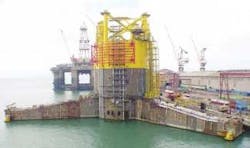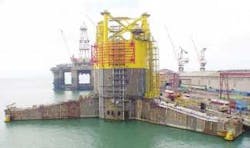Subsea/Surface Systems
Multiphase solution for Ceiba may expand
Framo Engineering reports success with the subsea multiphase pump system it installed on Triton Equatorial Guina's Ceiba field offshore EG. This installation, completed last fall, included two independent freestanding pump systems interfaced to the subesa production system via flow line connectors.
The system is driven by Framo's 1-mw electrically driven pump, which boosts production from two individual production wells to the Sendje Ceiba FPSO approximately 7 km from the booster station and production wells. The Ceiba field came on stream in 2000 with production from four early production wells It is on two of these wells that Framo installed their systems. Hess plans to apply a phased development with the Framo pumps for Ceiba full-field development. Based on the short-term success of these first pumps, Amerada Hess, parent company of Triton, is considering additional systems for other wells in the field.
The Ceiba reservoir has a high probability for high water production, which is actually an advantage when considering a multi-phase pumping solution. The goal with this project was obviously to increase the recoverable reserves from the field. To this end, the booster pumps have acted both as upside generators and downside protectors.
In addition to the pumps themselves, the systems include rigid M-style 6-in. jumpers with vertical connectors linking the suction end of the pump station with the christmas tree and the discharge end with the manifold. The pumps were installed in 2,500 ft of water. The electrical power is supplied to the pumps through a dedicated umbilical laid from the FPSO.
A separate line was run for each of the pump stations and a common facility installed on the deck of the FPSO to control the two pump stations. The topside building contains the variable speed drives, transformers, control, and auxiliary systems. Subsea transformers supply the electric motors with the required voltage. Electric/ hydraulic and signal jumpers were run between the subsea transformer, control unit, and pumps to supply power and control the functions.
Woodside taps FMC as preferred supplier
FMC Technologies has been chosen by Woodside Energy Ltd. as a preferred supplier of subsea production systems. This is the first agreement of its type in the Australian region.
The agreement is for five years, with options for extension. It covers the supply and support of subsea systems, including wellheads, subsea trees, subsea controls, manifolds and flowline tie-in and intervention systems, as well as engineering and life-of-field services.
The agreement will cover Woodside Energy's requirements for future subsea oil and gas developments, initially offshore Australia but with potential for global application. It is intended that some of the equipment will be manufactured in Australia.
FMC also recently landed the Sonatrach oil offloading project in Algeria. Sonatrach-TRC, the Algerian oil and gas company, selected FMC to development five offshore loading stations for transportation of crude oil and condensate from onshore facilities.
The total project scope, valued at approximately $240 million, includes the supply of five Sofec CALM (catenary anchor leg mooring) type buoys for export terminals with associated PLEM (Pipeline End Manifolds), as well as onshore and offshore pipelines and onshore facilities. The onshore facilities include metering and pumping stations.
FMC Technologies plans to subcontract the pipeline design, supply and installation and the onshore facilities to OPE. The estimated value of the OPE package is approximately $120 million, making the resulting estimated value of the project to FMC Technologies approximately $120 million. The project is anticipated to be completed in 2004.
Matterhorn hull fabrication complete
Atlantia Offshore, a member of the IHC Caland Group, reports the TotalFinaElf E&P USA Matterhorn SeaStar TLP hull fabrication has been completed at the Keppel Fels yard in Singapore. This is Atlantia's first dry-tree SeaStar hull to be fabricated outside the Gulf of Mexico. It is also the largest SeaStar built to date.
null
The Matterhorn hull measures twice the size of the previous three SeaStar projects. The hull had its formal naming ceremony in January, and is now preparing to be loaded onto the heavy-lift transportation vessel that will transport the hull to Pascagoula, Mississippi, in the Gulf of Mexico for offloading.
Successfully completed on time and budget, the execution of the hull construction met the full requirements of its specifications. The fabrication of the SeaStar hull started in January 2002 and was completed by year's end. This process achieved a record of more than 1 million incident-free man-hours at Keppel Fels.
The completed Matterhorn hull will remain idle in Pascagoula for approximately two months while it waits on final installation in Mississippi Canyon block 243. Following the installation of the piles, tendons, and hull, the topsides will be installed ready for platform start-up. The piles and topsides are being fabricated at Gulf Marine Fabricators and the tendons at Keiwitt Offshore.
Daniel Valve ships 30-in. subsea swing check valve
Daniel Valve has shipped a 30-in. swing check valve for a major operator's subsea pipeline in about 800-ft water depth. Made and tested in accordance with API-6D Q1, the cast body design conforms to ANSI B16.34. Fixtures for grasping and ROV intervention are as per API 17D. Valve features include a self-locking worm gear to raise the clapper to full open and serve as a lock-open device.
A unique clutch mechanism allows the clapper to swing freely in normal operation. Raising the clapper allows easy testing, line draining, reverse or smart pigging, sphere passage, and other reverse-flow operations. Manual operation is provided by a handwheel.
The valve has chevron-type seals on the shaft. A packing injector and pressure relief valve allow secondary shaft sealing. Sea caps on cover bolting and 316 stainless steel overlays protect the valve seal area from corrosion. A stainless steel integral seat features a 45° tapered seal surface for better sealing and reverse sphering/pigging.

